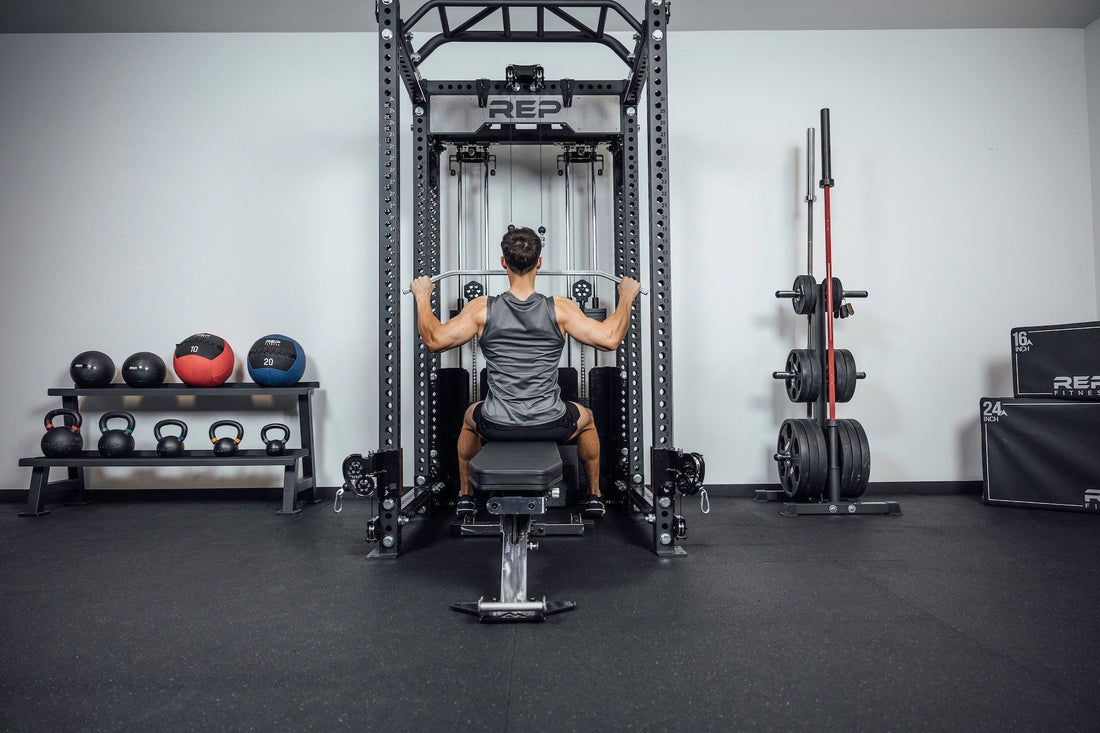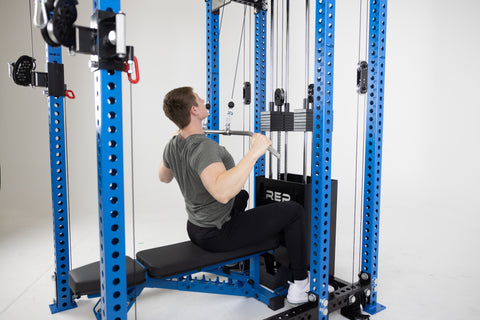
Lat pulldowns are an essential exercise for building a strong and broad back – and the benefits of this reach far beyond aesthetics.
Whether you're a beginner or an experienced lifter, understanding proper lat pulldown form, variations, and common mistakes of the lat pulldown will help you maximize the benefits of this exercise.
Lat Pulldown Benefits
A strong back brings a ton of benefits to your everyday life. It helps you maintain better posture, easing back pain and reducing the risk of injury during daily tasks or workouts. Plus, having a strong back boosts your overall strength and stability, making everything from lifting heavy objects to playing sports easier. (Powerlifters know the saying: “Big back, big total.”)
On top of that, back-strengthening exercises can also support your metabolism, helping with weight management and improving heart health.
Lat pulldown exercises are an effective way to target your back muscles, which play a crucial role in posture and daily activities that involve pulling motions, such as opening doors or lifting objects.
Lat Pulldowns Muscles Worked

The lat pulldown primarily targets the latissimus dorsi, or "lats," which are the large muscles that run down the sides of your back. Additionally, lat pulldowns engage your biceps and middle back, contributing to overall upper body strength. Lat pulldowns also work the teres major (near the shoulder blades) and rhomboids.
The back is a complex muscle group that requires variation for optimal development, so experimenting with different angles and hand positions is crucial. The lat pulldown can be incorporated into back workouts, upper body routines, pull-focused workouts, and full-body sessions.
How To Do Lat Pulldowns Correctly

1. Set Up
- Sit comfortably on the pulldown seat or bench with your feet flat on the floor.
- If possible on your cable machine, adjust the lat pulldown bar height so you can grasp it comfortably with outstretched arms without needing to stand up fully. You should also be able to extend your arms completely for a full range of motion.
- If you have a leg roller (thigh pad), adjust it so your thighs are securely tucked under the pad. This provides stability when you apply effort to the bar.
2. Grip and Pull
- Grab the bar with a wide, overhand grip (palms facing away from you). While there are various grip options, let's start with this position.
- Begin the movement by engaging your shoulder blades, then pull the bar down toward your chin while keeping your upper torso stationary. Exhale during this downward motion. It’s okay to lean slightly back but avoid excessive movement.
- Stop pulling when your elbows align with your torso. Do not pull the bar a lot lower than your chin to prevent undue stress on your shoulder joints.
3. Return to Start
Slowly return the bar back to the starting position, controlling its ascent. Avoid letting the bar crash into the weight stack. You want to control both directions of the lift.
4. Reps
A standard workout plan is to perform 8 to 12 repetitions per set, although that may vary based on your plan and goals. Rest, then continue with the desired number of sets.
Lat Pulldown Tips
Core Engagement: Keep your core engaged to prevent excessive arching of the spine during the movement.
Avoid Momentum: Control the movement throughout each rep to ensure the back muscles are doing the work, not your forearms or momentum.
Grip Variation: If you find your biceps taking over the movement, consider using a “false grip” (without wrapping your thumb around the bar) to shift the focus back to your lats.
Shoulder Blade Movement: Allow your shoulder blades to move naturally. Don’t lock them down; instead, let them rotate slightly at the top of the movement and engage them fully before pulling with your arms.
Common Mistakes to Avoid With Lat Pulldowns
Arching Your Back: Maintain an upright posture with a neutral spine to protect your lower back.
Using Your Forearms: Focus on initiating the movement with your lats, not your forearms, to ensure proper muscle activation.
Pulling Too Low: Stop pulling when the bar reaches your chin. Pulling beyond this point can place unnecessary stress on your shoulder joints.
Using Momentum: Perform the exercise slowly and with control to maximize muscle engagement and minimize the risk of injury.
Doing Behind-the-Neck Pulldowns: This variation is not recommended due to the increased risk of shoulder and neck injuries.
To stay safe and get the most out of lat pulldowns:
Check Your Form: Always ensure proper form to prevent strain on your wrists, elbows, and shoulders.
Adjust Weight Accordingly: Start with a weight that allows you to complete your set with good form. Gradually increase as you build strength.
Consult a Pro: If you have any pre-existing conditions, such as shoulder or back issues, consult with a healthcare provider or fitness professional before incorporating lat pulldowns into your routine.
Lat Pulldown Variations

Incorporating different variations of the lat pulldown can help target specific muscle groups and add variety to your workouts:
- Wide Grip Lat Pulldown: Emphasizes the upper lats, helping to create a broader back.
- Close Grip Lat Pulldown: Focuses more on the middle back, offering a more concentrated contraction. You can use a triangle row or the REP® x Kleva Built® Atlas™ Close-Grip Cable and Landmine Handle Attachment for close grip lateral pulldowns.
- Neutral Grip Lat Pulldown: Uses a V-bar or handles, reducing stress on the shoulders while targeting the middle and lower lats. Even better: A neutral grip lat bar.
- Underhand Lat Pulldown: Engages the biceps more heavily while still working the lats.
- Straight Arm Lat Pulldown: Isolates the lats and improves mind-muscle connection without involving the biceps.
- Standing Lat Pulldown: Adds core stability to the exercise, making it more challenging.
-
Kneeling Lat Pulldown: Similar to the standing variation but performed on your knees, which adds a stability challenge.
- Straight-arm lat pulldown: Try these with the REP® USA long leather accessory strap. Attach it to a high pulley. Stand facing the machine, grip the strap with both hands at shoulder width, keep your arms straight (with a slight bend at the elbows), and pull the strap down in an arc until your hands reach your thighs, engaging your lats throughout the movement.
Lat Pulldown Alternatives

If you’re looking for variations to the cable lat pulldown, consider the following exercises:
- Pull-Ups: The most direct alternative, requiring full bodyweight and offering similar benefits.
- Bent-Over Rows: Engages the lats, traps, and rhomboids, providing a comprehensive back workout.
- Single-Arm Cable Rows: Allows for unilateral work, helping to correct muscle imbalances.
Lat Pulldown vs. Pull-Up
Both lat pulldowns and pull-ups are excellent exercises for building back strength. The main difference is that lat pulldowns allow for adjustable resistance, making them more accessible for beginners or those recovering from injury. Pull-ups, on the other hand, require lifting your entire body weight, which can be more challenging but also more effective for overall strength development.
Learn more about how to improve your pull-ups here.
Learn More About Lat Pulldowns
Want to learn more?
- Best Home or Commercial Gym Storage With a Lat Pulldown
- The Best, Unexpected Exercises on a Lat Pulldown Machine
- Is This the Single Best Attachment for a Power Rack?
Bottom Line
The lat pulldown is a versatile and effective exercise for developing a strong, broad back. By mastering the basic form and experimenting with different variations, you can tailor this exercise to your specific goals and fitness level.
Whether you’re incorporating it into a back day, a full-body workout, or using it as an alternative to pull-ups, the lat pulldown is an invaluable tool for building upper body strength. Always prioritize proper form and technique to get the most out of your lat pulldown workouts while minimizing the risk of injury.

NEWSLETTER SIGNUP
Product launch information, promotions, blogs, and REP news.







